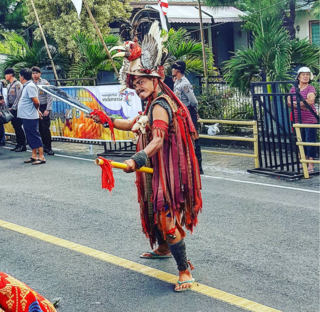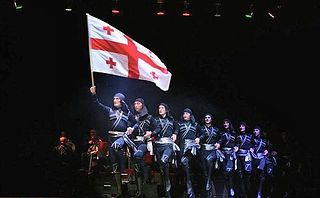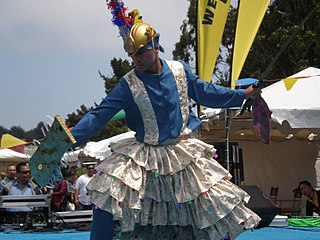 W
WA war dance is a dance involving mock combat, usually in reference to tribal warrior societies where such dances were performed as a ritual connected with endemic warfare. Martial arts in various cultures can be performed in dance-like settings for various reasons, such as for evoking ferocity in preparation for battle or showing off skill in a more stylized manner. It could also be for celebration of valor and conquest. Many such martial arts incorporate music, especially strong percussive rhythms.
 W
WCakalele dance is a war dance from North and Central Maluku in Indonesia. Hybrid versions also exist among the aboriginals of Sulawesi, Timor, and the Tanimbar Islands. The dance is performed by men, two of whom represent opposing captains or leaders while the others are the warriors supporting them. After an opening ritual, the captains engage in a mock-duel with a spear (sanokat) and long knife (lopu) while their supporters use a long knife in the right hand and a narrow wooden shield in the left hand. The shield is referred to as a salawaku, or by a local name such as the Tobelo o dadatoko. The cakalele originated as a way for the warriors to celebrate after a successful raid. Dancers dress in full warrior costume and are backed by the rhythm of the drum and gong (tifa) and fife (sulin).
 W
WCalinda is a martial art, as well as kind of folk music and war dance in the Caribbean which arose in the 1720s. It was brought to the Caribbean by Africans In the transatlantic slave trade and is based on native African combat dances.
 W
WCapoeira is a Brazilian martial art that combines elements of dance, acrobatics, and music. It was practiced by enslaved Africans in Brazil at the beginning of the 16th century. It is known for its acrobatic and complex maneuvers, often involving hands on the ground and inverted kicks. It emphasizes flowing movements rather than fixed stances; the ginga, a rocking step, is usually the focal point of the technique. The most widely accepted origin of the word capoeira comes from the Tupi words ka'a ("forest") paũ ("round"), referring to the areas of low vegetation in the Brazilian interior where fugitive slaves would hide. A practitioner of the art is called a capoeirista.
 W
WChhau dance, also spelled as Chau or Chhaau, is a semi classical Indian dance with martial, tribal and folk traditions, with origins in Mayurbhanj district of Odisha, and slowly panned out to neighbouring regions of Jharkhand and West Bengal. It is found in three styles named after the location where they are performed, i.e. the Purulia Chau of Bengal and the Seraikella Chau and the Mayurbhanj Chau of Odisha.
 W
WThe Cibi is a Fijian meke of Bauan origin and war dance, generally performed before or after a battle. It came to prominence in the rugby field in 1939 when it was performed by the Fiji national rugby union team before the match. It is also known as Teivovo
 W
WThe Devil's Sword Dance is a sword dance usually performed by a group of eight dancers, especially popular in northeastern Japan. It is so called because the dancers wear face masks which look like demons .
 W
WHaka is a posture dance in Māori culture. It is often performed by a group, with vigorous movements and stamping of the feet with rhythmically shouted or chanted accompaniment. Although commonly associated with the traditional battle preparations of male warriors, haka have long been performed by both men and women, and several varieties of the haka fulfil social functions within Māori culture. Haka are performed to welcome distinguished guests, or to acknowledge great achievements, occasions or funerals.
 W
WHopak is a Ukrainian folk dance originating as a male dance among the Zaporozhian Cossacks but, later danced by couples, male soloists, and mixed groups of dancers. It is performed most often as a solitary concert dance by amateur and professional Ukrainian dance ensembles, as well as other performers of folk dances. It has also been incorporated into larger artistic opuses such as operas, ballets and theatre.
 W
WJangi is a national male dance of Azerbaijan.
 W
WKabasaran is a traditional Minahasan war dance from North Sulawesi in Indonesia. It is performed by several men clad in red costumes, wielding a sword with a shield or a spear. The dancers are called kawasalan, which implies imitating like a pair of fighter cocks. the word kabasaran is derived from kawasalan.
 W
WKhattak dance is a swift martial attan dance usually performed while carrying a sword and a handkerchief by the tribesmen from the agile Khattak tribe of Pashtuns in Pakistan and some eastern parts of Afghanistan. It was performed by Khattak warriors before going to wars in the time of Malik Shahbaz Khan Khattak, and then Khushal Khan Khattak. It was used as a war-preparation exercise and is known to be the only dance with swordplay. Aside from the Pashtun's classical literature, popular ballads, the Pashtunwali, the khattak is part of the group's collective identify.
 W
WThe Khorumi is a war dance that originated in the region of Guria/Adjara, which is located in the southwestern region of Georgia. The dance was originally performed by only a few men. However, over time it has grown in scale. In today's version of the Khorumi, thirty or forty dancers can participate. The dance was inscribed on the Intangible Cultural Heritage of Georgia list in 2013.
 W
WThe Ohafia War Dance is a popular war dance performed in several parts of Eastern Nigeria. The dance which has its roots from Ohafia is performed by a group of muscular men in commemoration of their strength in fighting and winning wars in the past.
 W
WSagayan is a Philippine war dance performed by both the Maguindanao and Maranao depicting in dramatic fashion the steps their hero, Prince Bantugan, took upon wearing his armaments, the war he fought in and his subsequent victory afterwards. Performers, depicting fierce warriors would carry shields with shell noisemakers in one hand and double-bladed sword in the other attempting rolling movements to defend their master.
 W
WThe Sword Dance is one of the best known of all Highland dances, an ancient dance of war. Performance of sword dances in the folklore of Scotland is recorded from as early as the 15th century.
 W
WThe Manu Siva Tau is a Samoan war dance, performed by the Samoan sporting teams before each match.
 W
WSword dances are recorded throughout world history. There are various traditions of solo and mock-battle (Pyrrhic) sword dances from Africa, Asia and Europe.
 W
WTakalo is a Niuean war dance. Performed by an individual warrior or group of warriors, the dance is a formal challenge. The dance was traditionally performed prior to engaging the enemy with traditional war clubs.
 W
WVelakali is a traditional martial dance of Nair community of Kerala, India that is performed during temple festivals. Brightly dressed dancers wielding swords and shields depict a fight sequence between the Pandavas and Kauravas during the course of the dance.